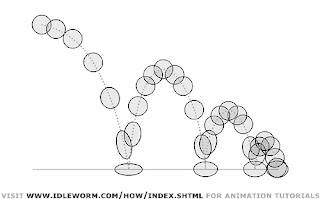This unit is to get us better aquatinted with animation and the strict physics a realistic animation employs. This physics can be broken down into 9 key principles.
Squash & Stretch - This can demonstrate the mass and rigidity of a thing. If a squishy ball hits the ground from high up, as it hits the ground its height will contract and it will get wider, as soon as it begins to leave the ground on rebound, these alterations will begin to reverse and the ball will start to resume standard appearance. [As the ninja hits his target, the targets legs bend to take the force of the ninja]
Arcs - Pretty self explanatory, if something is tossed into the air, up, but also in a direction, it will arc, up - middle - down again. [Ninja's jump must also have a convincing arc, as his jump starts he will gain altitude and then from the middle point will descend on the target]
Motion Blur - Enhances the appearance of motion but must be used very tastefully. [Ninja is very fast, and the jump will only be short, so a decent amount of blur should be put on]
Motivation & Anticipation - Preparation for an action, giving anticipation to the audience. The obvious preamble to something happening [Ninja ready to jump to target, unsheathes his sword and bends his legs and become poised]
Follow Through - The proper finishing of something, the ball bounces, it does not just stop moving when it hits the floor. Follow through is crucial for leading from one action to another as well as for wrapping things up nicely. [Ninja jumps onto his target, the target's legs bend and he collapses under the force of the ninja. The ninja also bends his legs to suitably deal with the force of the target, which he is now on, hitting the floor. He remains steadily on top of the target]
Staging & Exaggeration - Presenting something so that it is unmistakably clear. An object or movement that could be missed by the viewer but should not be, can be made clearer by things like coloration, camera focus or even sound. [As the ninja hits the target, he puts his sword to the target's neck, when he does this, the camera moves in quickly to the targets neck and the action is shown in slow-motion, lasting only a second, the camera quickly zooms back out and normal speed is resumed]
Timing & Speed of Change - This is spacing actions out and building them with them with the correct number of keyframes to express their weight, size and motion. The keyframes in-between a start and stop can define everything about an object within the animation and, like the other principles, can make the difference between natural and unnatural. [Animating ninja jumping on someone, put almost no keyframes between the start and end of jump, this implies ninja is very fast and skilled.]






No comments:
Post a Comment